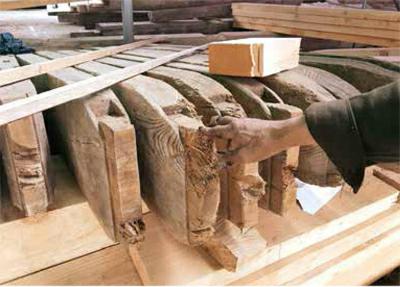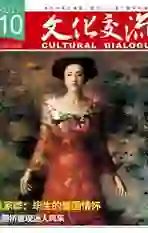文物专家与廊桥工匠:磨合中的协奏曲
2017-10-17汪子芳
汪子芳
2016年9月15日中秋夜,受台风“莫兰蒂”影响,温州泰顺县“国保”廊桥薛宅桥、文重桥、文兴桥,相继被山洪冲垮。
泰顺山水相间,溪流蜿蜒,廊桥跨水而起,村民们在两岸次第聚落。在当地人心中,它一直如精神图腾般地存在。
2017年3月末,三座廊桥的修复开工,8月12日,首先完工文重桥。
廊桥修旧如旧,打捞回来的木构件如何使用,新增的木料又如何添加?廊桥侧重文物性还是安全性?文物专家和工匠们却各有坚持。
文物修复比建造新桥更难
作为“世界桥梁史上的奇迹”,从明代开始,泰顺廊桥就承载起浙南文化的乡土记忆。廊桥在历史风雨中屡毁屡建,这几乎成了当地人的一种习俗和仪式,一种特殊的文化情结。去年中秋夜,三座廊桥被洪水冲垮,泰顺民众来不及悲痛,便和政府部门、非遗保护中心的工作人员一起,第一时间加入到“全民救桥”的行动中。
熟悉廊桥的人都知道,每座廊桥大大小小的木构件有1000多,被洪水冲垮后,越多找回原有的木构件,就意味着廊桥修复的可能性越大。由于抢救及时,廊桥90%以上的大、中木构件都被找回,原木构件晾干之后重新使用,这成了廊桥修复的关键性因素。
廊桥被冲垮后的最初几天,泰顺县非遗保护中心的工作人员沿着河流寻找被冲走的木构件,每天往返40多公里。历经20多天,三座廊桥的大部分原木构件从河堤埠墈打捞起来,从田间地头寻找回来。除了尽可能找回原木构件,工作人员还要抓紧寻找廊桥修复所需的备料。
2009年,泰顺廊桥所属的“中国传统木结构营造技艺”被联合国教科文组织列入《人类非物质文化遗产代表作名录》。季海波作为泰顺县非遗保护中心主任,廊桥修复工程的具体执行工作自然就归到了他的身上。从修复开工以来,季海波一直在三座廊桥的修复现场之间奔波,执行文物专家制定的方案,与廊桥营造技艺传承人沟通修复细节。“廊桥修复比重建一座新桥更难,耗时也更长,这要求修复后的廊桥最大程度保持原样,还必须保证它的文物性和安全性。”季海波多次解释。
木料构件如何使用
与新建廊桥不同,被冲毁的三座廊桥是“国保”,修复工程就必然包含专业文物修复和非遗技艺传承两类不同背景的专家,各有坚持。薛宅桥、文重桥、文兴桥的主墨师傅,分别是郑昌贵、赖永斌和曾家快,他们都是业界响当当的大师,都有独立新建廊桥的技艺和经验,可这次廊桥修复不同。
以薛宅桥为例。“在薛宅桥上,我们可以看到500年前的木料,也能看到清朝、民国时期的木构件,这意味着,每一次大修都尽可能保留了古桥的原件,桥本身就具有历史感。”季海波介绍,这与专家的要求相符——修旧如旧,保留桥体的历史印迹,即文物属性。
“廊桥的原木构件有很多历史信息,特别是各构件之间的卯榫关系,体现了当时的建造工艺和水准。”浙江省古建筑设计院黄贵强工程师介绍,廊桥的修复理念应该是尽可能利用原木构件,并对残损的木构件进行加固。
可是,工匠更在意廊桥的安全和牢固程度。“毕竟,廊桥修起来不仅是摆在那里让人看,它们还要有实用性,两岸的村民都要从桥上走路,还要防止洪水袭击。”薛宅桥的主墨师傅郑昌贵坚持。
在所有被打捞寻回的原木构件中,只有一部分原件可以原样使用,大多数损毁严重,无法直接使用,工匠认为,原木构件残损可能会影响安全。
“原件做上去,不好看又不牢固,我们希望部分用新料替换,安全也美观。”郑昌贵师傅说,新旧木料的柔韧性、承压能力有差异,损伤的原件就应该用新料代替。他的主张也代表了另外两位主墨师傅的想法。
但工匠的想法被专家否决了:“文物修复的基本法则就是最少干预、不改变文物原件。”
廊桥修复如何两全其美?
专家坚持文物保护理念,而工匠主张桥体安全理念,两者产生分歧,有没有两全其美的办法,让双方达成一致?
文物保护的理念不可更改,黄贵强和省里的专家团队来到泰顺,一遍遍与工匠沟通,想让对方厘清新旧木料之间的区别。“师傅们说原木件的卯榫损坏了,我们就想办法,看有没有别的方法将這些原木构件用到桥上面去。”
在协商过程中,季海波带着专家和工匠做木测试,比如,尝试将原有的木件改小,替换到另一个位置上,或者,用古人使用的藤条在木料的连接部位进行加固,增强木构件的抗压性能,再或者,测试不同墩接的承压性能。
工匠按照要求测试,寻找最牢固可靠的墩接技术,接好之后将木料悬空并大力敲击,测试卯榫位置的单点承重力,再经专家测试通过,才在建筑过程中使用并进行推广。
在专家和工匠互动的过程中,除了各自的分歧点,也出现过很多意外的惊喜。比如,在后期整理文兴桥的原木构件时,主墨师傅曾家快又翻出一些可原样使用的构件,“那时候,所有人比挖到金子还高兴”。
虽然各有坚持,但所有人的初衷都是为了修复廊桥。工匠们像是钉在现场的“钉子”一样,放弃休息,全力修复廊桥。
8月12日上午,一个喜讯传来,文重桥主体工程顺利完工,比预定工期提前了两个月。
目前,廊桥的整体修复工程已经完成三分之二,薛宅桥和文兴桥也已经完成屋脊铺瓦、椽条归位,之后,将修复桥台,整治廊桥的周边环境,安装防洪防火和测量移位的感应器等。
屡毁屡建,经历风雨而不消亡,相信在今年11月底前,三座古色古香的廊桥将会挺立如初,依然跨越在浙南的山水之间。endprint
(本文照片由作者拍攝、提供)
Restoration of Damaged Covered Bridges in Taishun
By Wang Zifang
Taishun in the southern part of Zhejiang Province boasts a total of 46 covered bridges built in the Tang (618-907) and the following dynasties and well preserved. Nineteen of the 46 were inscribed as provincial cultural relics in 2005 and 15 of the 46 were designated as national cultural relics 2009. In 2009, Chinese Traditional Architectural Craftsmanship for Timber-framed Structures was inscribed on UNESCOs Representative List of the Intangible Cultural Heritage of Humanity. Covered bridges of Taishun were part of the timber-framed structures. Since then tourists have flocked to Taishun for seeing the architectural wonders.
On the night September 15, 2016, the super typhoon Meranti slashed Taishun County in southern Zhejiang and subsequent floods brought down Xuezhai Bridge, Wenzhong Bridge and Wenxing Bridge, all under the protection of the state government.
As soon as the bridges went down, the rescue operation began. Villagers, government officials and employees at the center for protection of intangible cultural heritage worked together to retrieve wooden components of the three bridges. Each covered bridge has over 1,000 prefabricated components. The more retrieved, the better opportunities to restore the bridges. Over the few days after the floods caused by the typhoon, the employees of the protection center walked for over 40 kilometers along the streams several times to spot and retrieve all the scattered components. Eventually, about 90% of the original components were salvaged, paving the way for restoration projects. Meanwhile, efforts were made to prepare for the restoration projects.
“Restoring a covered bridge would be more difficult and more time-consuming than building a new one. Its because a restored bridge needs to retain its original condition as a cultural relic as much as possible and because it must ensure safety for the public who use the bridge every day,” explained Ji Haibo, director of the protection center.
Zheng Changgui, Lai Yongbin and Zeng Jiakuai are respectively in charge of each of the three restoration projects. They are masters who can build a covered bridge from scratch. The restoration projects ran into the same problem at the beginning. As the three covered bridges are national cultural relics, what principles were applied to the restoration projects? In the projects were professionals engaged in cultural relic restoration and experts in the field of preservation and inheritance of intangible cultural heritage. They have different focuses.endprint
Take Xuezhai Bridge for instance. The retrieved components were from different historical phases. Some were five hundred years old whereas some were installed respectively in the Qing (1644-1911) and in the early 20th century.
Ji Haibo wanted to keep the original time-worn conditions as much as possible. Huang Guiqiang from Zhejiang Ancient Architectural Design Institute suggested that all the retrieved components be used and even partly damaged components be repaired and used again. Zheng Changgui disagreed. As the master in charge of restoring Xuezhai Bridge, he emphasized safety as the top priority, pointing out that the bridge should be in safe use for a long time in future and the restored bridge shall be strong enough to withstand future floods. He proposed to use new components to replace most of the retrieved components which were damaged to varying degrees. The experts opposed the proposal.
The experts and the three masters sat down and discussed to seek a solution that would keep the restored bridges as cultural relics and would be good enough for everyday use and strong enough to withstand floods.
The masters agreed to examine all the retrieved components and see if partly damaged big components could be recycled to be smaller ones. The remodeled blocks would be tested scientifically first before they were approved to go into the restored structure. The masters also proposed to use rattan stems to further reinforce the mortise and tenon joints of retrieved components. The masters also developed a new procedure to test the best spots for key components to come together. The experts approved the procedure. Some new brand wood components have gone into the bridges.
At present, the main part of Wenzhong Bridge was restored on August 12. Two thirds of Xuezhai Bridge and Wenxing Bridge have been restored. Modern devices will be installed to monitor the conditions of the bridges and help them withstand future floods.
The restoration of three covered bridges is scheduled to be complete by November 2017.endprint
